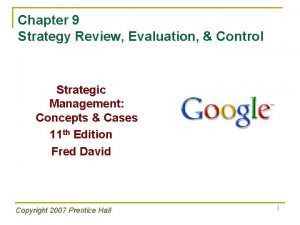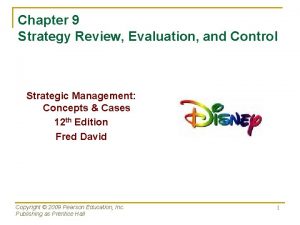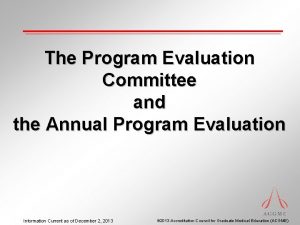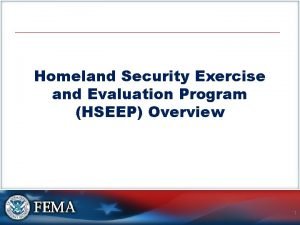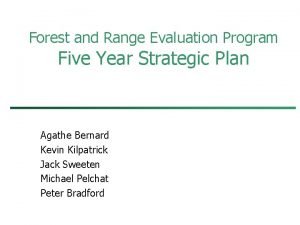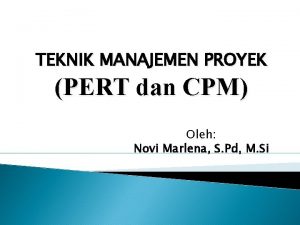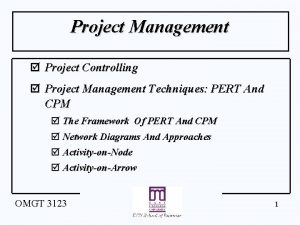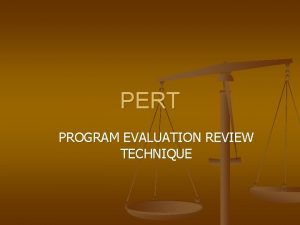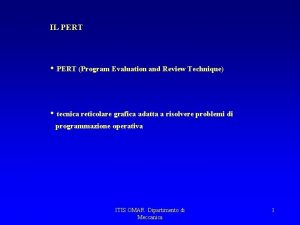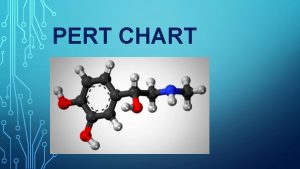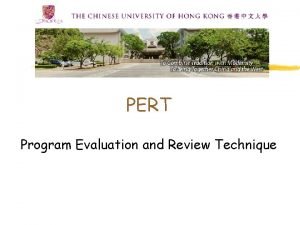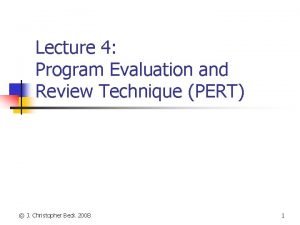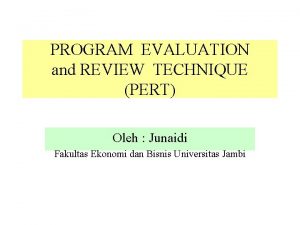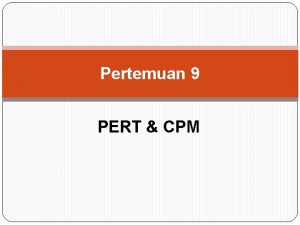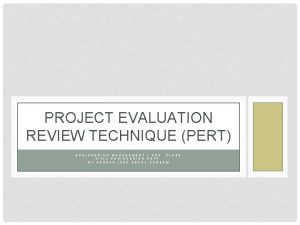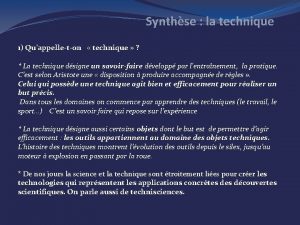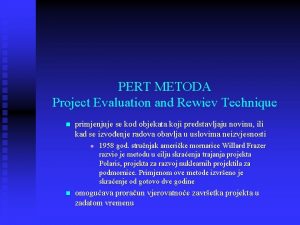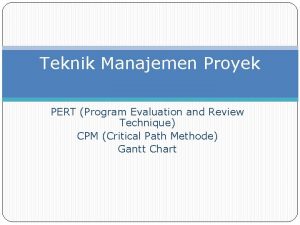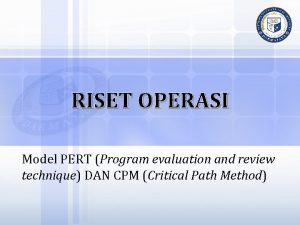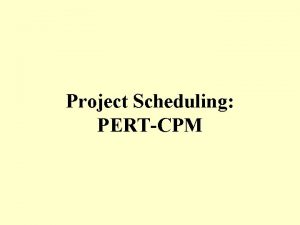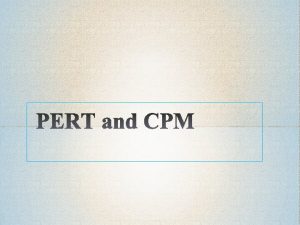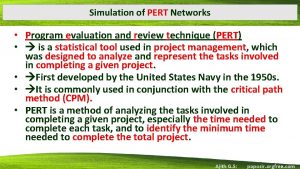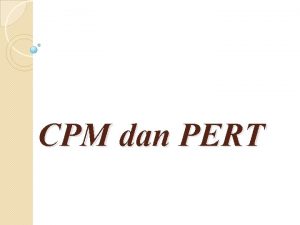PERT Program Evaluation Review Technique PERT PERT is

























![Solution Q 3 1 B [0, 5 ] 5 [5, 10 ] 0] 6, Solution Q 3 1 B [0, 5 ] 5 [5, 10 ] 0] 6,](https://slidetodoc.com/presentation_image_h2/953198176fa95256ea2b84a286de9105/image-26.jpg)

- Slides: 27

PERT Program Evaluation & Review Technique

PERT • PERT is used for Dealing With Uncertainty. • So far, times can be estimated with relative certainty, confidence. • For many situations this is not possible, e. g. Research, development, new products and projects etc. • PERT uses 3 time estimates m= most likely time estimate, a = optimistic time estimate, b = pessimistic time estimate, and

PERT Most likely estimate (m) : estimate of the most likely value of the duration, Optimistic estimate (a) : estimate of the duration under the most favorable conditions, Pessimistic estimate (b) : estimate of the duration under the most unfavorable conditions. Expected Time Variance Std Deviation (TE) = (a + 4 m + b) /6 (V) = ( ( b – a) / 6 ) 2 ( ) = SQRT (V)

Calculating Activity Times

Comparison Between CPM and PERT 1 CPM PERT Uses network, calculate float or slack, identify critical path and activities, guides to monitor and controlling project Same as CPM 2 Uses one value of activity time Requires 3 estimates of activity time Calculates mean and variance of time 3 Used where times can be estimated with confidence, familiar activities Used where times cannot be estimated with confidence. Unfamiliar or new activities 4 Minimizing cost is more important Meeting time target or estimating percent completion is more important 5 Examples: construction projects, building one off machines, ships, etc Examples: Involving new activities or products, research and development etc

CPM vs. PERT CPM - Critical Path Method In CPM activities are shown as a network of precedence relationships using activity-on-node network construction • Single estimate of activity time • Deterministic activity times USED IN : for the jobs of repetitive in nature where the activity time estimates can be predicted with considerable certainty due to the existence of past experience. PERT - Project Evaluation & Review Technique In PERT activities are shown as a network of precedence relationships using activity-on-arrow network construction • Multiple time estimates • Probabilistic activity times USED IN : for non-repetitive jobs (research and development work), where the time and cost estimates tend to be quite uncertain. This technique uses probabilistic time estimates.

PERT CPM 1. PERT is used for non-repetitive jobs like planning the assembly of 1. CPM is used for repetitive job the space. like building a house 2. it is a probabilistic model. 3. It is event-oriented as the results of analysis are expressed in terms of events or distinct points in time indicative of progress. 2. It is a deterministic model. 3. It is activity-oriented as the result or calculations are considered in terms of activities or operations of the project. 4. It is applied mainly for planning 4. It is applied mainly for and scheduling research construction and business programmes. problems.

PERT 5. PERT incorporates statistical analysis and thereby determines the probabilities concerning the time by which each activity or entire project would be completed. 6. PERT serves as useful control device as it assists management in controlling a project by calling attention to such delays CPM 5. CPM does not incorporate statistical analysis in determining time estimates, because time is precise and known. 6. It is difficult to use CPM as a control device for the simple reason that one must repeat the entire evaluation of the project each time the changes are introduced into the network.

Uncertainty of Project Completion Time • First calculate a standard normal variable, Z • Then, use the Z value to find the probability from the Z- table. • Probability Estimate: It is used to calculate the probability of completing the time within given duration T 1(Using Normal Distribution): Z = (T 1 – Tcp)/ σp

Therefore, the expected completion time of the project can be derived as well as the variability in the project completion time ( p ), as follows: Std. dev. p =√ (sum of the variances of the duration for the activities in the critical path)

Question (AOA) (A) Calculate Expected time, Variance, Standard Deviation, & Slacks for the table below. (B) Assume, PM promised to complete the project in the fifty days. What are the chances of meeting that deadline? (C) What deadline are you 95% sure of meeting? Immediate Optimistic Most Likely Pessimistic Predecessor Time A - 10 22 22 B - 20 20 20 C - 4 10 16 D A 2 14 32 E B, C 8 8 20 F B, C 8 14 20 G B, C 4 4 4 H C 2 12 16 I G, H 6 16 38 J D, E 2 8 14 Activity Time

Question 1 (AON) Find: • The AON network. • All expected activity times, variances, and slacks. • The critical path & expected completion time. • The probability the project will be done in 23 days. • The completion time corresponding to 95% probability. (Perform all calculations up to 4 decimal places)

Solution Q 1 Activity a b c d e f g TE 4 2 5 4 6 1 6 2 var. = 1 0. 11 0. 44 1 1 Slack 0 7 0 11 0

4 Solution Q 1 8 d 4, 0. 11 11 0 4 4 a 4, 1 0 0 4 0 2 4 9 b 2, 0 0 0 7 g 6, 1 15 15 Legend: 9 15 21 9 9 EF LF 21 End e 6, 0. 44 21 15 10 f 1, 1 20 LS 21 9 9 ES 21 c 5, 1 0 Start 15 21 21

Solution Q 1 3. Critical path is a-c-e-g for a time of 21 days. 4. Std. Dev. p = √Sum of variances of activities on critical path = √ var(a) +var(c) +var(e) +var(g) = √ 1+ 1 + 0. 44 + 1= √ 3. 44 = 1. 855 Z = (23 – 21)/ p = (23 – 21)/ 1. 855 = 1. 08 for a probability of 85. 99%. 5. P = 0. 95 corresponds to z = 1. 65 = (T -21)/1. 855, or T = 24. 06 days.

Question 2 (A) Calculate Expected time, Variance, Standard Deviation, & Slacks for the table below. (B) Assume, PM promised to complete the project in the fifty days. What are the chances of meeting that deadline? (C) What deadline are you 95% sure of meeting? (Perform all calculations up to 4 decimal places) Immediate Optimistic Most Likely Pessimistic Predecessor Time A - 10 22 22 B - 20 20 20 C - 4 10 16 D A 2 14 32 E B, C 8 8 20 F B, C 8 14 20 G B, C 4 4 4 H C 2 12 16 I G, H 6 16 38 J D, E 2 8 14 Activity Time

Solution Q 2 Immediate Optimistic Most Likely Pessimistic EXP Activity Predecessor Time A - 10 B - C Time Var S. Dev Time TE V 22 22 20 4 2 20 20 0 0 - 4 10 16 10 4 2 D A 2 14 32 15 25 5 E B, C 8 8 20 10 4 2 F B, C 8 14 20 14 4 2 G B, C 4 4 0 0 H C 2 12 16 11 5. 4 2. 32 I G, H 6 16 38 18 28. 4 5. 33 J D, E 2 8 14 8 4 2

Solution Q 2 CRITICAL PATH : ADJ = 43 2 6 D 15 J 8 20 A E B 20 3 7 F 14 C 0 1 4 G Dummy I 18 1 10 4 H 11 5

Solution Q 2 The complete network 2 D (20, 35) 15 (20, 35) 0) ) 3 , 5 0 (2 5, 3 E (2 10 A 20 (0, (0 20) , 2 0) 3 0) , 1 4) (0 , 1 C 0 (4 1 Dummy 4 7 F (20, 34) 14 (29, 43) G 4 ( (20, 21 24) , 25 ) H(10, 21) 11 (14, 25) I (2 18 4, 4 (25 2) , 43 ) B (0, 20) 20 (1, 21) ) 43 5, 3) (3 , 4 J (35 8 1 6 5

Solution Q 2 Slacks ACTIVITY LS ES SLACKS CRITICAL ? A 0 0 0 YES B 1 0 1 C 4 0 4 D 20 20 0 E 25 20 5 F 29 20 9 G 21 20 1 H 14 10 4 I 25 24 1 J 35 35 0 YES

Solution Q 2 (B) Assume, PM promised to complete the project in the fifty days. What are the chances of meeting that deadline? Calculate Z, where Z = (T 1 -Tcp) / cp (= V) Example, T 1 = 50; Tcp= 20+15+8 =43; V = (4+25+4) =33 Z = (50 – 43) / 33 = (50 – 43) / 5. 74 = 1. 22 The probability value of Z = 1. 22, is 0. 888 or 88. 8% 1. 22

Solution Q 2 (C) What deadline are you 95% sure of meeting? Z value associated with 0. 95 is 1. 65 Z =1. 65 = (T- 43) / SQRT(4+25+4) T= 52. 47 days Thus, there is a 95 percent chance of finishing the project by 52. 47 days.

Question 3 a) Draw the AOA network for this project. b) Find the critical path for this project network. c) Calculate expected activity times and slacks. (Perform all calculations up to 4 decimal places)

Solution Q 3 First construct the network and label activities D 2 4 G A E C 1 5 B F 3 24

Solution Q 3 Solution – add ES, LS, EF, LF 2 4 G 6 C 4 E A 6 4 1 D 4 B 5 3 5 F 6 25
![Solution Q 3 1 B 0 5 5 5 10 0 6 Solution Q 3 1 B [0, 5 ] 5 [5, 10 ] 0] 6,](https://slidetodoc.com/presentation_image_h2/953198176fa95256ea2b84a286de9105/image-26.jpg)
Solution Q 3 1 B [0, 5 ] 5 [5, 10 ] 0] 6, 1 C [ , 10] 4 [6 , 6] 0 [ A , 6] 0 6[ D [6, 10] 4 [10, 14] 4 E 4 [ [10, 10 14 , 14 ] ] 2 3 G 6 [ [14, 14 20 , 20 ] ] 5 16] , 0 1 [ F 0] 6 [14, 2 a. Critical path: A-C-E-G; Time: 20 months 26

Solution Q 3 Slacks ACTIVITY LS ES SLACKS CRITICAL ? A 0 0 0 YES B 5 0 5 C 6 6 0 D 10 6 4 E 10 10 0 F 14 10 4 G 14 14 0 YES YES
 Fedex balanced scorecard
Fedex balanced scorecard Consonance in strategic management
Consonance in strategic management Program evaluation committee checklist
Program evaluation committee checklist Mixed methods program evaluation
Mixed methods program evaluation Implementing hrd programs pdf
Implementing hrd programs pdf Hseep exercise types
Hseep exercise types Program evaluation
Program evaluation Forest and range evaluation program
Forest and range evaluation program Chapter review motion part a vocabulary review answer key
Chapter review motion part a vocabulary review answer key Writ of certiorari ap gov example
Writ of certiorari ap gov example Nader amin-salehi
Nader amin-salehi Inclusion criteria examples
Inclusion criteria examples Narrative review vs systematic review
Narrative review vs systematic review Precision fluency shaping program
Precision fluency shaping program Comlex level 2 ce prep course
Comlex level 2 ce prep course Hcri stuttering therapy cost
Hcri stuttering therapy cost Differences between sequential and event-driven programming
Differences between sequential and event-driven programming Perangkat lunak pada komputer disebut?
Perangkat lunak pada komputer disebut? Merancang program tahunan dan program semester
Merancang program tahunan dan program semester Microsoft excel merupakan aplikasi …
Microsoft excel merupakan aplikasi … Program pengolah kata adalah
Program pengolah kata adalah Ms word
Ms word Manajemen proyek backward pass
Manajemen proyek backward pass Pert algebra
Pert algebra Pert formula
Pert formula Pert stands for
Pert stands for Project objectives slide
Project objectives slide Pert metoda
Pert metoda
